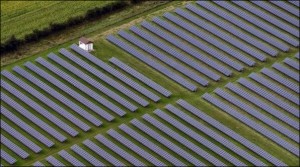 In remarks made at a business conference Friday, CEO Thomas F. Farrell II noted how much land solar panels consume. As paraphrased by the Richmond Times-Dispatch, he said:
In remarks made at a business conference Friday, CEO Thomas F. Farrell II noted how much land solar panels consume. As paraphrased by the Richmond Times-Dispatch, he said:
A solar project that Dominion hopes to build near Culpeper would occupy 125 acres of land and power about 5,000 houses — about 30 percent of the time. By contrast, a natural gas plant in Warren County sits on 39 acres and can power 335,000 houses — about 80 percent of the time.
Writing in a Sunday op-ed piece, T-D columnist Bart Hinkle extrapolated from Farrell’s numbers: “Dominion can generate more than 24,000 megawatts of power all together. To get that from solar power alone would require more than 1,000 square miles of solar panels.”
Assuming Hinkle’s got his numbers right, that’s roughly equivalent to putting Chesterfield County, Henrico County, the City of Richmond and half of Hanover County under solar panels in order to supply the state’s electricity needs. That’s a serious amount of real estate.
In all fairness, Hinkle’s example is somewhat extreme: No one is calling to convert 100% of Virginia’s electric power to solar. Indeed, Virginia’s Renewable Portfolio Standard sets a voluntary goal of only 15% for the state’s electric power to come from renewable sources, which also includes wind and biomass. And the state energy plan also calls for energy conservation as an alternative to building new generating capacity. But the example dramatizes how much land Virginia will have to dedicate to solar in order to make meaningful progress toward renewable energy goals.
It might be worth debating the pros and cons of converting thousands of acres of land to solar. We should discuss the environmental impact — what kind of wildlife would prosper in fields of solar panels? What would the visual impact be on habitat does fields of solar panels make? How do we minimize the adverse visual and environmental impacts?
I’m serious, solar panels could become one of Virginia’s most extensive land uses. This is something we need to start thinking about.
Update: Commenters have made the valid point that comparing the footprint of solar facilities to that of, say, a natural gas -fired generator is not fair unless it takes into account the right-of-way gas required for the pipeline that serves the gas plant, not to mention the gas storage and drilling facilities associated with the generator. Also, considerable solar capacity could be installed on rooftops.
— JAB


